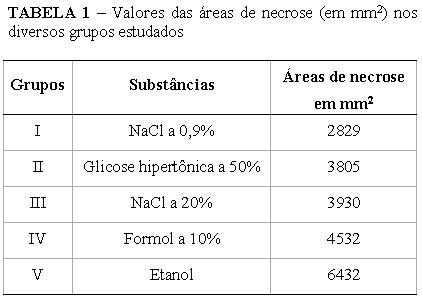PURPOSE: To investigate the extent of necrosis after the injection of four substances into the liver of rats. METHODS: Twenty-five male Wistar rats (weighting from 200 - 250g) and divided into five groups were used for this study. All the animals underwent a transverse laparotomy, each receiving 0,1ml of the following substances into the liver parenchyma: Saline solution (1st Group - Gr. I), 50% hypertonic glucose (2nd Group - Gr. II), 20% NaCl (3rd Group - Gr. III), 10% formaline solution (4th Group - Gr. IV) and ethanol (5th Group - Gr. V). All the animals were sacrificated 24 hours after surgical procedures. The livers were examined microscopically to measure the extent of induced necrosis. RESULTS: The results achieved were the following: 2829mm² - Gr. I; 3805mm² - Gr. II; 3930mm² - Gr. III; 4532mm² - Gr. IV; and 6432mm² - Gr. V.. Statistical analysis were made with Kruskal-Wallis test and P less than 0,05 were considered statistically significant. CONCLUSIONS: 1. A saline solution causes hepatic necrosis, although to a lesser extent than the other substances (P < 0,05). 2. 20% NaCl and 50% hypertonic glucose produce necrosis to the same extent (P > 0,05). 3. The necrosis induced by a 10% formaline solution was greater than that induced by 50% hypertonic glucose (P < 0,05) and 20% NaCl (P > 0,05). 4. The hepatic injection of ethanol produced the most intense hepatic necrosis when compared to saline solution, 20% NaCl, 50% hipertonic glucose and 10% formaline solution (P < 0,05).
Liver; Necrosis; Rats

 Experimental induction model of hepatic focal necrosis: in rats
Experimental induction model of hepatic focal necrosis: in rats